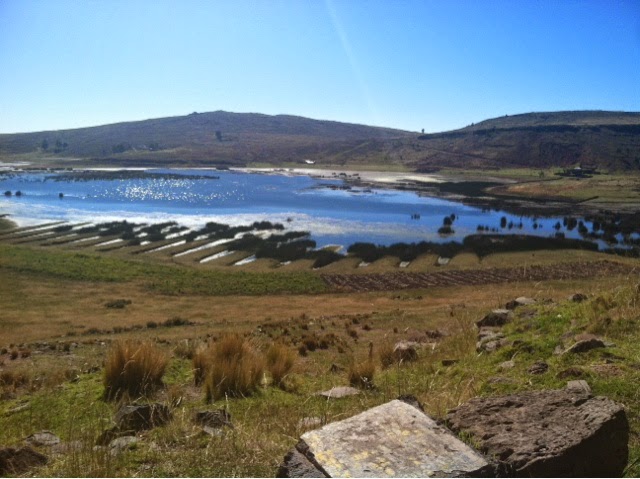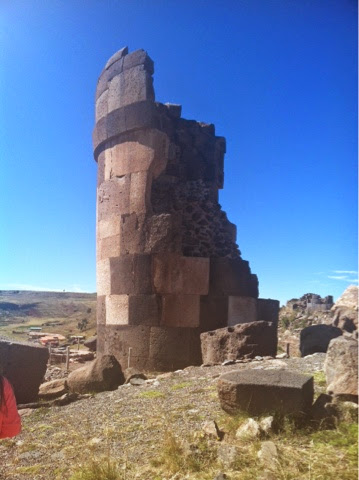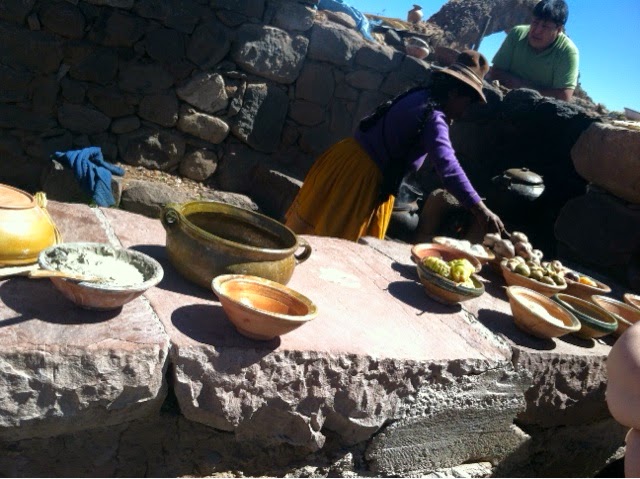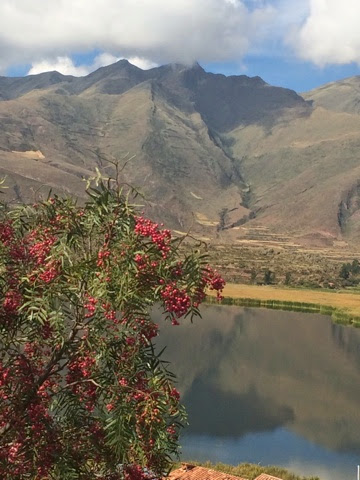After a quick tour of the market, we hopped back on and drove through Miraflores, an upper middleclass district where our hotel was located--it was amazing to see how clean and well-kept this district of Lima was and the houses and architecture were beautiful. We also drove through part of San Isidros, a nice district where we saw a pyramid constructed before the city of Lima was "established" by Francisco Pizarro. Although we weren't able to stop at the pyramid, it was interesting to see how the native people of Lima attempted to construct a mountain-like figure to serve as a means of worship in an area of Peru that lacks mountains.
After the pyramid, we stopped at a colorful park in Miraflores that overlooks the ocean shore. The park was quite beautiful with a large statute created by Víctor Delfín, colorful tiled walls, and various flower gardens. There was even a random piano in the middle of the park and a few of us stopped to play! Near the park, we saw an underground mall--a very popular stop for tourists and businesspeople passing through Lima. Then, we entered a distrcit called Barranco. This district holds many large, beautifully constructed homes that served as "ranchos" for people looking to move to the coast for health or vacation reasons in the past. We were able to walk by many of these summer homes or "ranchos" in Spanish, but unfortunately, we were unable to see their interior.
We passed through a few more districts before riding up a small mountain-like hill on the south side of Lima where we were able to view nearly the entire city of Lima and take some nice photos. Near this area, we also saw various areas of shanty towns, poorer residential areas that are still in early stages of developing, largely belonging to the lower working class or people who had moved from the rural areas ot the city. Our guide Franz was quite knowledgable about these areas. He explained how the shanty towns go through three different stages of development and then expanded to give us some examples of how the Peruvian informal and formal economy works. He also gave us a bit of insight into the mining industry of Peru. We were all very thankful to have a knowledgable guide with experience in many different areas of Peru. Franz did a great job helping us understand the economics, politics, and history of many different places/concepts in Peru.
To conclude our tour, we stopped at a small restaurant to try Anticucho--a Peruvian delicacy consisting of the meat of the heart of a cow. Almost everyone tried the beef heart and enjoyed its rich flavor and tenderness. We also drank Chicha Morada, a purple-corn based juice-like drink that was very sweet and delicious. It was a perfect meal for our last lunch in Peru.
After lunch we were allowed a few hours of free time. Our portion of the group (along with Kathleen) decided to make the trek down to the beach (while others did some last minute shopping)! After taking quite a few stairs, we made it down to the shower where we dipped our feet in the water, skipped stones, and took photos. It was absolutely beautiful here. However, the beach conisted of small sleek stones instead of sand which both tickled and hurt our feet at the same time. We were tempted to take some surf lessons while at the beach, but the thought of sitting on a plane soon after without a shower was a turn off. Altogether, though, the beach was a beautiful area to spend our last few ours of our trip.
Before departing for another quick bus tour on our way to the airport, everyone in the group reuinted at Tanta (a quechua word for "potato") a fun restaurant where we all ate delicious food, drinks, and desserts! Afterwards, we saw various historic areas of Lima lit up at night including the plaza of San Martín and the Plaza de Armas which consisted of the presidentail palace, some municipal buildings, and an elegant cathedral. The night tour was beautiful, but we were sad we couldn't stay longer to explore the places up close. Finally, we arrived at the airport right outside of Lima, said our goodbyes to Franz and our bus driver, and headed inot the airport. We could not believe the trip had gone by so fast. After an 8 hour plane ride that went quite smoothly, we all went our separate ways in JFK. It was a bittersweet ending to a trip full of experiences. I think I can speak for our whole group when I say that Peru exposed us to an entirely new world filled with distinct cultures, traditions, people, food, and geography. It was an amazing trip that we will never forget, with a group of great people whom we will always remember.
¡Adios Amigos!






















































